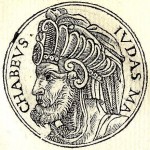"...wherever we look, it appears that Jesus was aware of a great battle in which he was already involved and that would, before too long, reach some kind of climax." However, the battle that Jesus was involved in wasn't what His contemporaries were expecting him to fight. It was different because the enemy was a different kind of enemy.
| Temptation in the Wilderness |
The battle that Jesus waged was against this spiritual power. The influence of modern skepticism has made western people confused over the existence of such evil; on the other hand, as Wright warns, "the shrill retort from 'traditionalists', insisting on seeing everything in terms of 'supernatural' issues, hardly helps either...Despite the caricatures, the obsessions, and the sheer muddle that people often get themselves into on this subject, there is such a thing as a dark force that seems to take over people, movements, and sometimes whole countries, a force or a set of forces that can make people do things they would never normally do."
Wright goes out of his way to emphasize that without the understanding that evil is a dark force behind human reality, then the issue of "good" and "bad" becomes "fatally easy"; in other words, if we don't understand that there are real and dark forces behind institutions and groups and nations, we naively fall into categorizing and typecasting people like "us" as the basically good people and people like "them" as basically evil.
We must understand that there are non-human forces capable of using "us" as well as using "them" in the service of evil. This makes things more complicated but also more realistic and no longer allows us to be simplistic about who is being used by these forces..."If there is an enemy at work," says Wright, "it is a subtle, cunning enemy, much too clever to allow itself to be identified simply with one person, one group, or one nation..." (This is one of the great dangers in aligning oneself strongly with a political party since all political groups have dark forces at work behind them.)
In this spiritual battle Jesus was redefining who the enemies were and who the friends were. "Traditional enemies were suddenly brought, at least in principle, within the reach of the blessing of God's great jubilee. And traditional friends - those who might have thought that they were automatically on the right side - had to be looked at again. Perhaps one can no longer simply identify 'our people' as on the side of the angels and 'those people' as agents of the satan. That's why Jesus was run out of town and nearly killed. He had suggested that foes could become friends and by implications was warning that the 'good people' might become enemies..."
Jesus' battle was with the root problem - not people but "the satan," the dark force that works and uses "us" and "them". The early victory was won in the wilderness temptation when the satan failed to get Jesus to grasp the right goal by using the wrong means, thereby bringing Jesus over to his side (Matt. 4; Mark 1; Luke 4). This victory made possible Jesus' announcement that God's kingdom was beginning, and it "created a space in which God's kingdom can now make inroads, much as the early victory of Judah the Hammer created space for the Temple to be cleansed...But this kingdom, God's kingdom, can only finally be established through the final battle. The enemy troops will mass again, close in, and do their worst to repair the earlier damage."
The final battle was Jesus' confrontation with "the satan" on the cross where victory was won by allowing darkness to do its worst. Jesus didn't allow Himself to be distracted from the real battle by identifying the satan with the humans involved (Rome, Herod, the chief priests).
"Jesus has redefined the royal task around his own vision of where the real problem lies. And he has thereby redefined his own vocation, which he takes to be the true vocation of Israel's king: to fight and win the key battle, the battle that will set his people free and establish God's sovereignty and saving rule, through his own suffering and death."
The chapter finishes with a section on the Temple, the second major theme of the kingdom agenda that Jewish leaders understood to be imperative. More on that in a day or two...



